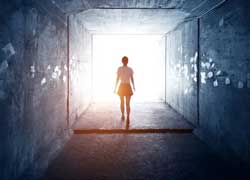Near-death experiences: 30 years of research
 Part 2
Part 2It was 1993, Kathleen Elmore, she was driving through an intersection and a truck was coming at her car from the left side. “This is not good,” she thought.
“Dying doesn't hurt,” said Elmore, as he recounted his experience at the International Association for Near-Death Studies (IANDS) at the 2011 conference.
“All that huge, huge impact felt like someone just tapped me on the shoulder, and I went straight up.”
Elmore said his consciousness went 50 or 60 feet up into a beautiful white light, where he felt "incredible love" and heard beautiful music. There, she met three beings who are "beyond angels", she said, and who had helped plan her life before she was born. She had a conversation with them as she watched the people rescue her below. After returning to life, she gained the ability to see the energy around the Earth and people's collective consciousness, she said.
Episodes that people experience when they are clinically dead or close to clinical death are chronicled as near-death experiences (NDEs) in a 1975 book called "Life After Life" by Raymond Moody, MD and Ph.D. in Philosophy and psychology. The book has attracted scholars to study the phenomenon, and led the IANDS foundation in 1981 to assist near-death research. Between September 2-4, 2011, NDEs and researchers gathered in Durham, NC, USA to share their experiences and discoveries over the past 30 years.
In part 1 of this series, we mentioned that Eben Alexander, MD, had an NDE when his brain was damaged by acute bacterial meningitis, and that Bruce Greyson, MD and director of the Division of Perceptual Studies at the University of Virginia, reported that functioning mental health is, in most cases, better during NDEs than usual, and that they can still remember their NDEs very accurately even 20 years after the event.
In this part, we look at the validity of NDEs through their aftereffects on NDEs.
 Bruce Grayson, MD, director of perception research at the University of Virginia,
Bruce Grayson, MD, director of perception research at the University of Virginia,
believes we can learn about near-death experiences by studying their aftermath
The study of after effects
During his talk at the IANDS conference, Greyson mentioned that some "pseudoskeptics", as he calls it, scientists closed to NDE discoveries, believe that the phenomenon of NDEs is not something that can be studied scientifically because NDEs are not material, and they cannot measure them.
Greyson argued that there has been a great deal of study done on emotions, while not acknowledging their material existence.
“Are love and fear material?” he asked. “There is certainly a lot of scientific research on these things. We cannot see them, but we can certainly measure their effects, and from their effects we have learned, scientifically, a lot about them.”
In a scientific study, there are many things that we measure indirectly. For example, physicists’ study dark matter not through direct observation of its existence, but through indirect means, such as calculating the mass discrepancy of a cosmic body estimated in different ways.
Last week, NASA announced that its Kepler mission confirmed the existence of an unseen planet, Kepler-19c, by observing the orbit cycle of a nearby planet, Kepler-19b, which is seen to be influenced by a force unknown gravity.
The Kepler mission team also published an article in the journal Science on September 16, 2011 about the discovery of the planet Kepler-16b orbiting two low-mass suns. The discovery was made from eclipses, some of which were made possible by the two suns obscuring each other.
Using the bubble chamber as an analogy, Greyson argued that the NDE can be studied scientifically. The bubble chamber is a vessel in which subatomic particles pass through a liquid, leaving a trail of bubbles in their wake. Particles are too small and moving too fast for us to observe them, but by watching the bubbles that form around their trajectories, we can learn about these particles. In the same way, Greyson said, we can learn about NDEs from their effects.
“For true scientists, the ultimate authority is experience, not theory,” he said.
Some might think these people must be religious, and their experiences could be their imagination. However, among these people there are those who were not religious prior to their NDE, and Greyson has found that one of the effects of NDEs is a reduction in religiosity. Interestingly, these patients, in general, also have heightened spirituality after their NDE.
Another thing Greyson found in her research is that, contrary to what might be expected, these patients are more inclined to use logical thinking after their NDE than before the experience.
In addition to psychological changes, electromagnetic effects are widely reported. When some of these people wear wristwatches, the batteries run low very quickly, or the watches run faster or slower than normal. Some of these people cause light bulbs to fail, or TVs and radios to change stations as they pass by. Greyson mentioned that a person was not detected by automatic doors.
Jane Katra, Ph.D. in public health, who also spoke at the conference, said that she became sensitive to vibrations and electromagnetic fields after her NDE, and that it was difficult for her to adjust to living in her parents' home because she became able to hear various things from different rooms.
These effects of NDEs make it difficult to deny them as real experiences, as mere hallucinations or being close to death would not bring these effects.
Greyson and Mitchell Liester, MD, are beginning a study of the electromagnetic effects of NDEs. After collecting data from a questionnaire, they will conduct studies to measure the electromagnetic fields of NDEs and the effects on clocks.
'The Day I Died' BBC (2003)



